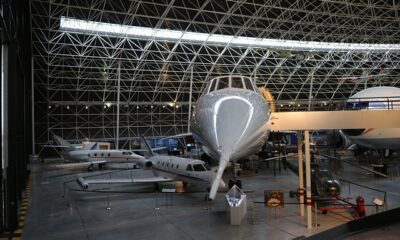Aviation
Emirates looks to windowless planes

The airline has just unveiled a new first class suite on board its latest aircraft that features “virtual windows” instead of real ones.
The President of Emirates, Tim Clarke, is hoping it will pave the way for removing all windows from future planes, which he says will make them lighter and faster.
Mr Clarke says on the inside there will be “a full display of windows,” which will beam in the images from the outside.
This will be done using fibre-optic camera technology. So, instead of being able to see directly outside, passengers will view images projected from outside the aircraft — which is almost like the real thing.
In fact, according to Mr Clarke, the technology beaming the images is even better than seeing it “with the naked eye”.
This means that when you look outside you can only see a projection instead of the real thing.
Emirates have unveiled designs for a new first class suite, which feature fibre optic cameras that beam an image of outside onto the window.
President of Emirates Sir Tim Clark told the BBC: “The quality of the imagery is so good, it’s better than with the natural eye. [It’s] as if you were in the window seat.
“So can the new generation of aircraft be windowless with this technology? In my view there’s no reason why not.” The sun reported
Watch other videos

Aviation
Exploring the Different Types of Helicopter Rotor Systems and the Science Behind Them

Helicopters are unique aircraft that use rotating blades, called rotors, to generate lift and enable flight. The design of these rotor systems is crucial because it affects how helicopters perform, maneuver, and respond to different flying conditions.
There are several types of helicopter rotor systems, each with its own advantages and specific uses. Understanding these systems helps us appreciate the engineering behind helicopters and their diverse capabilities, from search and rescue missions to military operations and aerial photography.
In this Video, we will explore the main types of helicopter rotor systems and how they contribute to the helicopter’s functionality and performance.
1. Single Rotor System
The single rotor system is characterized by a single main rotor blade that is responsible for generating lift. To counteract the torque produced by this rotor, a tail rotor is used. This setup is essential for maintaining directional control and stability during flight.
Uses: This design is prevalent in most conventional helicopters, including iconic models such as the Bell 206 and the Robinson R22. The simplicity of the single rotor system not only reduces mechanical complexity but also enhances efficiency. As a result, it is favored for a variety of applications, including aerial tours, law enforcement, and emergency medical services, where reliability and straightforward operation are paramount.
2. Tandem Rotor System
The tandem rotor system features two parallel rotors of equal size that rotate in opposite directions. This counter-rotation helps to cancel out the torque that each rotor would otherwise produce, resulting in a balanced and stable flight profile.
Uses: This configuration is typically employed in heavy-lift helicopters, such as the CH-47 Chinook. The tandem design allows for an increased payload capacity and enhanced stability, making it particularly effective for transporting troops, equipment, and supplies in military operations, as well as for civilian applications like logging and construction, where heavy lifting is required.
3. Coaxial Rotor System
The coaxial rotor system consists of two rotors mounted one above the other on the same mast, rotating in opposite directions. This innovative design minimizes the need for a tail rotor, allowing for a more compact helicopter structure.
Uses: Coaxial rotor systems can be found in helicopters such as the Kamov Ka-50. This design offers several advantages, including enhanced lift capabilities, improved maneuverability, and better control in various flight conditions. These features make it particularly suitable for military applications, where agility and quick response times are crucial, as well as for specific civilian operations that require high performance in tight spaces.
4. Intermeshing Rotor System
The intermeshing rotor system consists of two rotors that rotate in opposite directions while intersecting each other, but without colliding. This unique configuration creates a highly efficient aerodynamic profile.
Uses: This system is utilized in helicopters like the Kaman K-MAX, designed specifically for heavy lifting and aerial work. The intermeshing rotors provide remarkable stability and lift capabilities, making it particularly effective for operations in confined spaces, such as urban environments or dense forests. It is ideal for missions that involve heavy external loads, including construction, firefighting, and disaster relief efforts.
5. Transverse rotor system
The transverse rotor system has two parallel rotors that spin in opposite directions, improving lift and stability. This design enhances the aircraft’s aerodynamic efficiency and maneuverability.
A notable example of this system is the V-22 Osprey, a tiltrotor aircraft that merges helicopter vertical lift with the speed of a fixed-wing plane. allowing the Osprey to operate in tough environments like urban areas and remote locations. It can carry heavy loads and personnel, making it suitable for troop transport, search and rescue, medical evacuation, and logistical support in military operations. Overall, the transverse rotor system enhances the V-22 Osprey’s effectiveness and operational flexibility.
6. Compound Rotor System
The compound rotor system combines traditional rotor systems with fixed wings and other aerodynamic features to enhance efficiency and speed. This hybrid approach allows for greater aerodynamic performance than standard rotorcraft.
Uses: Advanced helicopters like the Sikorsky X2 and Boeing’s DBF (Defiant) utilize the compound rotor system. These helicopters are designed for higher speeds and longer ranges, making them suitable for military operations, search-and-rescue missions, and law enforcement tasks where rapid response and extended operational capabilities are essential.
7. NOTAR system
NOTAR system replaces the traditional tail rotor with a ducted fan and directional airflow to counter the torque from the main rotor. It works by pushing air through the tail boom and out through side vents, creating thrust that stabilizes the helicopter. This design reduces noise, boosts safety, and cuts down on maintenance.
Uses: The NOTAR system is found in helicopters like the MD 520N and MD 902 Explorer. Without an exposed tail rotor, it lowers the risk of rotor strikes, making it safer for operations in tight spaces. Its quieter performance is ideal for missions where low noise is needed, such as urban air operations, police work, and medical evacuations.
-

 Aviation2 months ago
Aviation2 months agoNew EU Carry-On Rules Begin September 2024: What to Expect
-

 Aviation2 months ago
Aviation2 months agoBoeing confirms 797: A New Era for Mid-Size Aircraft
-

 Aviation2 months ago
Aviation2 months agoLockheed and Tata Team Up to Build C-130J MRO Facility in India
-

 Aviation1 month ago
Aviation1 month agoMicrosoft Flight Simulator Raises $3 Million to Bring Back the An-225 Mriya
-

 Tech2 months ago
Tech2 months agoChina Developing Jet to Travel Anywhere in Two Hours
-

 Airlines2 months ago
Airlines2 months agoQantas Engineers Stage Walkout Over Cost of Living Concerns
-

 Aviation2 months ago
Aviation2 months agoBoeing Offers 25% Pay Increase & Promise to Build Next Plane in Seattle
-

 Airlines1 month ago
Airlines1 month agoQatar Citizens Can Travel to the United States Without a Visa








